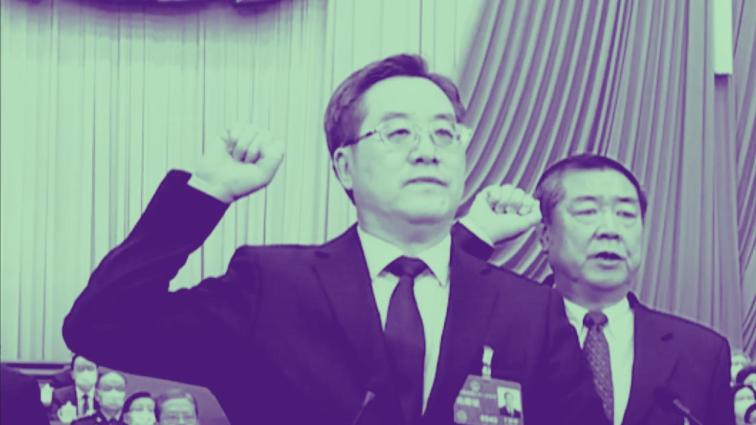Netizens traced a lead and zinc transportation station—Baiyin Nonferrous Group Changba Lead-Zinc Mine Tianshui Transfer Station—located only 2.5 km from the kindergarten involved. (Online image)
[People News] In the Heishi Peixin Kindergarten located in the Maiji District of Tianshui City, 251 children were tested, revealing that 233 had abnormal blood lead levels. Alarmingly, 40% of these children met the criteria for moderate to severe lead poisoning. Symptoms observed included abdominal pain, hair loss, and black spots on their gums. Even more concerning is that children who were classified as 'normal' in local tests were later diagnosed with moderate to severe poisoning at a hospital in Xi'an, with discrepancies in test results reaching several dozen times.
A rapid investigation report was issued, indicating that two food samples contained lead levels that far exceeded safety standards, measuring 1052 mg/kg and 1340 mg/kg, which were traced back to the use of non-edible colored paint purchased online in the kitchen. Eight individuals have been criminally detained, and several local officials have been held accountable.
While this response seems 'swift and thorough,' could it be too hasty?
The difference between local test results and those from the Xi'an hospital is staggering, with some cases showing discrepancies of several dozen times (for instance, Child A had a local blood lead level of 82 μg/L, while the Xi'an test indicated 512 μg/L), which far exceeds the permissible error margin of ±10% outlined in the 'Clinical Testing Technical Specifications for Blood Lead.'
We have reason to question whether this incident of 'artificial contamination' has fallen into a familiar pattern of response—individual blame and systemic silence.
In cases of public health and environmental pollution, the approach of 'quickly assigning individual responsibility while minimising structural accountability' is not a new phenomenon. This pattern typically unfolds as: blaming individuals → defining isolated incidents → closing the case → failure to address systemic issues.
1. In Gansu, pollution is no longer a newsworthy topic.
Gansu is a typical resource-based province with a long history of lead pollution in certain areas:
In 2006, in Wujihe Village, Maijishan District, Tianshui, emissions from a smelting plant resulted in abnormal blood lead levels in 334 children;
In 2009, in Huixian, Longnan, lead dust levels exceeded standards by 800 times, with 373 children severely affected;
In 2015, in Jinchang City, the lead concentration in farmland soil surpassed 200 mg/kg;
In 2018, in Baiyin City, 42% of the plough layer soil exceeded lead standards.
National soil monitoring data indicate that heavy metal accumulation is widespread in the northwestern industrial and agricultural border areas, with the soil lead accumulation rate in the arid agricultural regions of central and eastern Gansu reaching as high as 72.5%.
Is the recent large-scale blood lead anomaly in Tianshui simply the result of long-term environmental exposure combined with a single poisoning incident?
II. International Experience: Lessons from the Flint Crisis
In 2014, the lead water crisis in Flint, Michigan, USA, exemplified a significant institutional failure:
The government unilaterally changed the water source, leading to lead leaching from the pipes and affecting over 9,000 children;
Initially, there was denial from officials, prompting residents to conduct their own tests to reveal the issue.
The federal government declared a public health emergency.
$100 million was allocated to replace more than 10,000 lead pipes;
An amendment to the Safe Drinking Water Act was introduced to enhance testing and disclosure mechanisms.
Ultimately, the state government paid $600 million in compensation.
The American environmental organisation NRDC has noted that lead pollution impacts not only children; adults can also suffer from chronic issues such as high blood pressure, kidney damage, and neurodegeneration. While children are more susceptible, lead does not discriminate by age.
III. How should the government respond appropriately?
In contrast to the Flint incident, Tianshui's response clearly demonstrates a systemic inadequacy in addressing the issue:
No systematic environmental investigations or tracing have been carried out; there are significant inconsistencies in the conclusions drawn by local and external testing agencies, and there is a lack of unified quality control and review mechanisms. While responsibility for the kindergarten has been quickly identified, city-level risk assessments and governance measures have yet to be initiated. Historically, Tianshui in Gansu has made attempts at governance, but these have followed a fragmented model characterised by 'event-driven responses, media exposure, and short-term rectification.' Local governance is heavily reliant on oversight from higher authorities, while grassroots environmental protection and public health systems suffer from long-term resource shortages.
IV. How can we prevent the next instance of 'chronic poisoning'?
1. Establish an independent environmental investigation mechanism
The Ministry of Ecology and Environment should lead a comprehensive tracing effort, in collaboration with the National Health Commission and third-party professional organisations, to investigate air, water, soil, and emissions in Tianshui and its surrounding areas over the past decade.
2. Ensure comprehensive public disclosure of testing data
All testing reports must specify the submitting hospital, testing methods, original data, and review status, allowing parents and the public to cross-verify the information.
3. Include Tianshui in the national key governance areas
Tianshui should be classified as a 'key area for heavy metal pollution control,' similar to the 'Chang-Zhu-Tan cadmium governance model,' to promote systematic remediation efforts such as farmland restoration, pollution source containment, and enterprise relocation.
4. Conduct environmental risk assessments and renovations in schools
Environmental risk assessments should be performed for childcare institutions and schools, establishing a grading system with red, yellow, and green levels, where serious exceedances would necessitate relocation or closure for remediation.
5. Create a children's environmental health record system
Utilising the community health system, regular screenings for blood lead levels and other routine checks should be conducted for children aged 0-12, creating a dynamic database.
6. Advocate for the legislation of the 'Heavy Metal Pollution Prevention and Control Law'
It is essential to clarify the legal responsibilities of both the government and enterprises in concealing and delaying the disclosure of pollution information, and to establish a green channel for environmental public interest litigation. Lead is colourless and odourless. However, it may be lurking in the soil of your home, in your water pipes, in the air, or within the 'responsibility black box' that authorities are reluctant to confront.
The 'colourful steamed cake' may merely be a trigger for a larger issue. The real concern is whether there are systemic exposures that have not been identified, managed, or disclosed.
The implications of this incident should not end with sealing off individuals or suppressing discussions. Rather, it should mark the beginning of efforts to trace the origins of the problem, implement institutional reforms, and rebuild public trust.
Author's note: Over a decade ago, when I first started my career as a journalist, I served as an environmental reporter before moving on to cover food safety and healthcare issues. I have investigated national soil pollution and followed numerous food safety incidents, and I am acutely aware of the damaging effects of environmental pollution and food safety on individual health and societal trust. Now, as a mother, witnessing the blood lead levels in these children from Tianshui and seeing the isolation and helplessness of parents trying to take action is more heartbreaking than ever. △
Source: China Digital Times











News magazine bootstrap themes!
I like this themes, fast loading and look profesional
Thank you Carlos!
You're welcome!
Please support me with give positive rating!
Yes Sure!